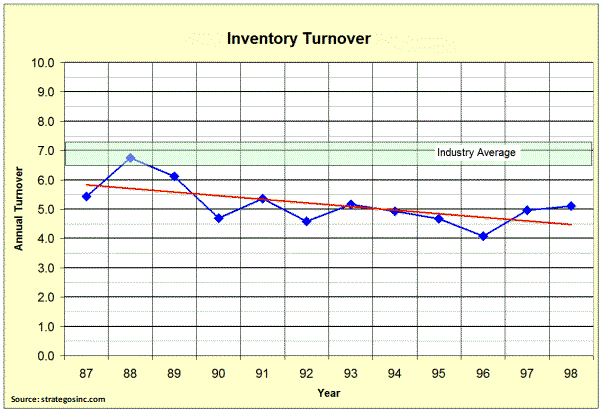In our travels around the industrial scene, we notice that many companies pay more attention to inventory Turns than they should. We would like to deflect some of this attention to more consequential performance metrics.
Recall the definition: Turns = Annual dollar cost of goods sold / Average dollar value of inventory. If you sell $1 million of stuff in a year and have an average of $100,000 of stuff on the shelf each day, you are running at an impressive 10 Turns (Walmart runs at around 8). Supposedly, having high Turns signals efficient management, and keeping your Turns higher than competitors’ signals competitive advantage.
But as happens with most performance metrics, there is more to the story. Turns may be very salient to the CFO, but they can be a straightjacket to the COO. This is because Turns are not directly related to customer service; in fact, high Turns can be synonymous with low service levels and fill rates. S&OP consultant Darrin Oliver calls Turns his “pet peeve metric” because “the customer doesn’t care about Turns.”
Suppose you are unhappy with your current Turns value. What can you do to boost the number? Since Turns is a ratio, you can increase it by either increasing the numerator (goods sold) or decreasing the denominator (inventory). Increasing sales is more difficult because it requires the cooperation of the customer. Decreasing inventory is easier because it’s completely under your control: just make smaller replenishment orders, which also saves money in the short run. Indeed, you can get very enthusiastic and cut inventory to the bone. You end up with a better looking number for Turns—and a serious problem with stockouts, backorders, lost sales, lost customer good will and lost market share. Who’s sorry now?
 Here’s a lightly edited version of a story on this topic told by a very wise practitioner. “Back in my other life they were all about improving Turns. Why, I have no idea. So I pointed out the risks that you run. And they really weren’t interested. So we took our global inventories down to [a lower level], and then were breaking on stock left and right on a daily basis. Our turns were great, but we weren’t making any money, because we couldn’t get anything out the door, because we didn’t own it. The higher your turns, the lower your inventory’s going to have to be, or you’re just going to have really good flow. And in our industry that’s a very, very difficult thing to achieve. So if we can have reasonable Turns but still be in stock, I think that’s what we want to do. It can be very frustrating in an operations world to try to explain what we do every day and what the risks to the business are when the financial people are just looking at one or two metrics. They’re basically trying to plan the business in a vacuum, and it’s very difficult and very risky to do that.”
Here’s a lightly edited version of a story on this topic told by a very wise practitioner. “Back in my other life they were all about improving Turns. Why, I have no idea. So I pointed out the risks that you run. And they really weren’t interested. So we took our global inventories down to [a lower level], and then were breaking on stock left and right on a daily basis. Our turns were great, but we weren’t making any money, because we couldn’t get anything out the door, because we didn’t own it. The higher your turns, the lower your inventory’s going to have to be, or you’re just going to have really good flow. And in our industry that’s a very, very difficult thing to achieve. So if we can have reasonable Turns but still be in stock, I think that’s what we want to do. It can be very frustrating in an operations world to try to explain what we do every day and what the risks to the business are when the financial people are just looking at one or two metrics. They’re basically trying to plan the business in a vacuum, and it’s very difficult and very risky to do that.”
Thomas Willemain, PhD, co-founded Smart Software and currently serves as Senior Vice President for Research. Dr. Willemain also serves as Professor Emeritus of Industrial and Systems Engineering at Rensselear Polytechnic Institute and as a member of the research staff at the Center for Computing Sciences, Institute for Defense Analyses.
Related Posts

Make AI-Driven Inventory Optimization an Ally for Your Organization
In this blog, we will explore how organizations can achieve exceptional efficiency and accuracy with AI-driven inventory optimization. Traditional inventory management methods often fall short due to their reactive nature and reliance on manual processes. Maintaining optimal inventory levels is fundamental for meeting customer demand while minimizing costs. The introduction of AI-driven inventory optimization can significantly reduce the burden of manual processes, providing relief to supply chain managers from tedious tasks.

Daily Demand Scenarios
In this Videoblog, we will explain how time series forecasting has emerged as a pivotal tool, particularly at the daily level, which Smart Software has been pioneering since its inception over forty years ago. The evolution of business practices from annual to more refined temporal increments like monthly and now daily data analysis illustrates a significant shift in operational strategies.

Constructive Play with Digital Twins
Those of you who track hot topics will be familiar with the term “digital twin.” Those who have been too busy with work may want to read on and catch up. While there are several definitions of digital twin, here’s one that works well: A digital twin is a dynamic virtual copy of a physical asset, process, system, or environment that looks like and behaves identically to its real-world counterpart. A digital twin ingests data and replicates processes so you can predict possible performance outcomes and issues that the real-world product might undergo.











